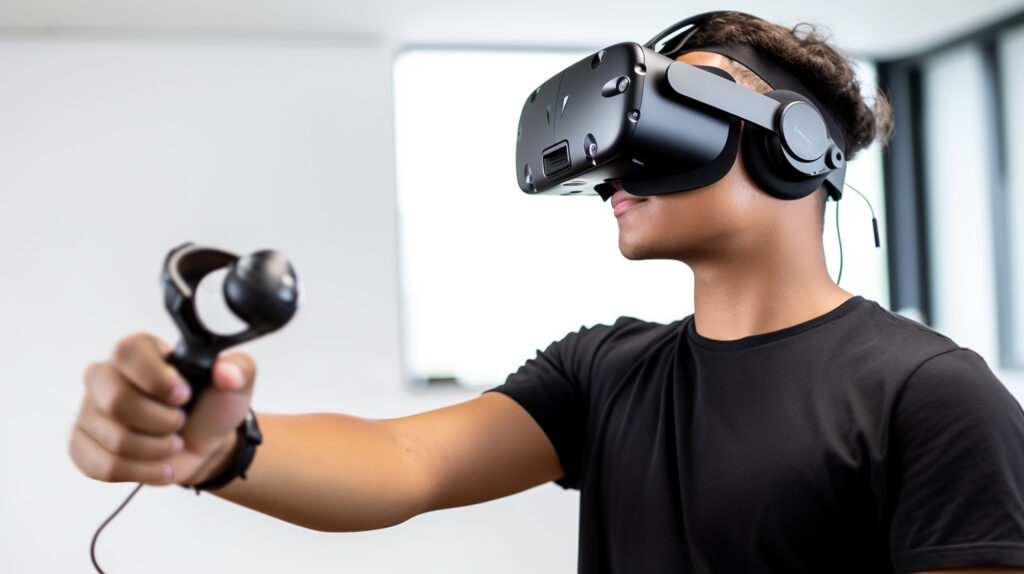In today’s super-connected world, brands are always on the hunt for the next big thing to grab attention. Enter Augmented Reality (AR) and Virtual Reality (VR)—tech that promises mind-blowing, immersive experiences to hook users and boost sales. But let’s be real, despite all the hype, AR/VR hasn’t exactly taken off like a rocket. Why? It’s been a bit of a hassle—think clunky gear, high prices, and a steep learning curve. But hold up! With the drop of Apple Vision Pro—a next-level mixed reality headset—things are about to get real. This could be the game-changer that finally makes AR/VR the go-to for brands looking to level up their marketing game.
What’s holding back AR/VR adoption? Let’s talk the hurdles and how to smash through them!
Despite the excitement surrounding AR and VR, these technologies face several hurdles that have kept them from becoming mainstream. One major challenge is the physical discomfort associated with VR headsets. Many users experience motion sickness, eye strain, and headaches after extended use. The bulky and cumbersome design of many VR devices can also make them uncomfortable to wear for long periods, limiting the time users are willing to spend in virtual environments and reducing the technology’s effectiveness as a marketing tool.
Another significant barrier is the high cost of AR and VR devices. Quality headsets and devices often come with a hefty price tag, restricting their accessibility to a small segment of the market. For brands aiming to reach a broader audience, this presents a considerable challenge. The financial investment required for both consumers and companies to adopt these technologies has slowed their widespread integration into everyday marketing strategies.
Finally, the complexity of AR and VR technology adds to the adoption challenges. Users frequently encounter a steep learning curve when trying to navigate these new environments. The process of setting up and using AR/VR devices can be daunting, requiring technical expertise that not everyone possesses. This complexity can lead to frustration and reluctance to fully engage with the technology, further impeding its broader adoption.
Apple Vision Pro: A Game-Changer

Apple, a company known for revolutionizing industries with its innovative products, has now entered the AR/VR market with its Vision Pro headset. This device is poised to overcome many of the challenges that have hindered the adoption of AR/VR and could be the catalyst that propels these technologies into the mainstream.
1. Seamless Blending of Digital and Physical Worlds
The Vision Pro is not just another VR headset; it represents a new category of device known as a “spatial computer.” It seamlessly integrates digital content with the physical world, allowing users to interact with both simultaneously. This ability to blend the virtual and real worlds without the need to completely disconnect from one’s surroundings addresses one of the major pain points of traditional VR—its isolating nature. With Vision Pro, users can move fluidly between digital and physical spaces, enhancing the versatility and appeal of the technology.
2. Intuitive, No-Touch Controls
One of the standout features of Vision Pro is its intuitive control system. Unlike traditional AR/VR devices that rely on physical controllers or touchscreens, Vision Pro uses eye-tracking and hand gestures for navigation and interaction. Users can simply look at a virtual object and perform natural gestures, such as pinching their fingers, to interact with it. This no-touch control system makes the device more accessible and user-friendly, reducing the learning curve and making AR/VR more appealing to a broader audience.
3. Advanced Technology for a Superior Experience
Vision Pro is packed with advanced technology designed to enhance the user experience. It features five sensors, eye-tracking technology, a LiDAR scanner, 12 cameras, and six microphones, all of which work together to create a highly responsive and immersive environment. The device runs on a new operating system called visionOS, which is entirely controlled by the user’s eyes, hands, and voice, eliminating the need for any physical input devices. These innovations make Vision Pro not only more comfortable and intuitive to use but also more powerful and capable of delivering truly immersive experiences.
How is AR/VR flipping the script on marketing?
As AR/VR technology becomes more refined and accessible, the opportunities for marketers to engage with customers in new and exciting ways are expanding. Below are some of the key applications of AR/VR in marketing that could revolutionize how brands interact with their audiences.
1. Product Visualization
One of the most promising applications of AR/VR in marketing is product visualization. With these technologies, customers can virtually try on products, such as clothing or accessories, or see how a piece of furniture would look in their home before making a purchase. This not only enhances the shopping experience but also increases customer confidence in their purchase decisions, leading to higher conversion rates. Brands like IKEA have already begun to leverage this technology with their IKEA Place app, allowing users to place virtual furniture in their real-world environment.
2. Interactive Storytelling
AR/VR offers brands the ability to create immersive narratives that engage customers on a deeper level. Through interactive storytelling, brands can transport customers to different worlds, allowing them to experience a product or service in a way that goes beyond traditional advertising. This type of engagement can create a strong emotional connection with the brand, fostering loyalty and driving sales.
3. Virtual Events
In the era of remote work and virtual gatherings, AR/VR can take virtual events to the next level. These technologies enable brands to host virtual conferences, product launches, and other events in immersive environments that provide a more engaging and interactive experience for attendees. This can be particularly valuable for reaching global audiences and creating a sense of presence and community, even when participants are physically distant.
4. Accessibility
Beyond marketing, AR/VR has the potential to improve accessibility for people with disabilities. The intuitive controls and minimal physical interaction required by devices like Vision Pro can make digital content more accessible to individuals with physical limitations. For example, the combination of eye movement and simple hand gestures could enable users with limited mobility to interact with digital environments in ways that were previously impossible. This not only broadens the audience for AR/VR experiences but also enhances inclusivity, allowing brands to reach a more diverse range of customers.
Transform Your Brand with Cutting-Edge Immersive Technologies
At Simelabs, we are at the forefront of the immersive technology revolution, offering expertise in Metaverse development, Digital Twin creation, Augmented Reality (AR), Virtual Reality (VR), Mixed Reality (MR), and cutting-edge Research. Our team is dedicated to helping brands navigate this new era of digital experiences, ensuring they stay ahead of the curve. Whether you’re looking to create a virtual showroom, develop a digital twin of your operations, or explore the endless possibilities of the Metaverse, we have the skills and knowledge to bring your vision to life.
Let’s collaborate to transform your brand’s digital presence and create truly unforgettable experiences for your customers.
Reach out to us today to start your journey into the future of immersive marketing.
